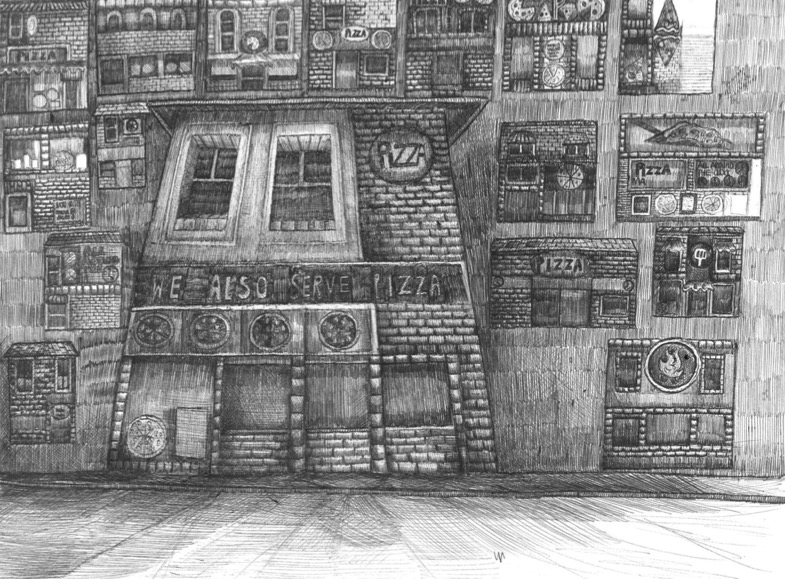Featured image: Lilibelle Anthony
There were no benches near the Domino’s pizza in Chorlton, and it was far too hot to bother walking to a nearby park. Out of laziness, we perched atop a rusty metal fence. The thin bar across the top wasn’t wide enough to balance on properly, but we persisted against gravity, the heat, and the precariousness of pizza boxes.
I’ve been to old family restaurants, an endless parade of Neapolitan pizza joints, I’ve been to Italy – and the pizza was better in Glasgow. I’ve had some good pizza. None have yet topped the pizza my friends and I balanced across our laps on that sweltering day in 2015.
Fish and chips will always taste better by the seaside, cheese sandwiches after a hike, bananas after a swim. The quality of the food does matter, but my personal theory is that most of the taste of food comes from the context in which it’s eaten. I cannot recall how the best pizza I’ve ever eaten tasted, but I can reach out and touch the heat and my friend and that Domino’s pizza right now. Of course, back then, Domino’s had a fairly unique selling point.
You can categorise pizza into four types: store-bought, fast food, restaurant, and homemade. The truth is, these might as well be recognised as wholly separate and unique foods. There is no way that a store-bought pizza is even comparable to a restaurant pizza, and I’m sure that the nation of Italy would agree that fast food pizza and homemade pizza share almost no genetics. And of course, you wouldn’t be caught dead putting mayo on a pizza in a restaurant, but in the comfort of your own home? Why stop at mayonnaise? This was part of the appeal of chain pizza – the dip. The weird sauce packet in the corner of the box might’ve scared you as a kid but you’d soon learn that this is what set pizzas apart. Papa Johns had that blasphemous (and delicious) cheesy, buttery thing going on, Pizza Hut was always forgettable, Domino’s were clearly putting something highly addictive in their garlic and herb dip. Back in the mid-2010s, the dips were what made fast food pizza worth getting, it’s what set them apart from the restaurant quality places.
Now though, walk into any pizza parlour and you will be assailed by dips. Hot honey, garlic aioli, nduja, nduja aioli (if it can be turned into aioli it will be), truffle mayo – you name it. Why? Because all pizza places are becoming the same place.
I’m not totally sure when it started, the mid-2010s I suspect, but all of a sudden all the restaurants began to look the same. You’ve been there – exposed brick, pipes snaking in plain view across the ceiling, shadeless lightbulbs hanging limply, unvarnished wood, ceramic tiles if you’re lucky. Every genre of mid-scale restaurant has been affected, from Indian to chicken shops to Mexican joints. The pizza place, though, has been hit particularly hard.
In Manchester alone, I can think of four local pizza franchises, some of whose doughy tendrils are already stretching outside of the central borough, that look exactly like that. But the reason pizza places have been so highly affected is because of the introduction of Neapolitan pizza. The issue is that judging by the number of very good pizza places around, it is not hard to make a high-quality Neapolitan.
So, all of a sudden, you’ve got a tonne of pizza that looks identical, making pizza of roughly similar quality, so what do you do, as the owner of a pizza place, to distinguish yourself? You start offering dips.
I call it the dipping wars, an arms race of interesting things to dunk your slices in. Again, nobody knows where it started, but it is no ingrained now that it’s hard to imagine an alternative. I’ve seen people my age turn their noses up at pizzas without dip, supermarkets are selling dip – dip has become as much a part of a pizza as the cheese and the sauce. And it really is an arms race. Including the list above, there are some truly wild dips out there from honey with chilli flakes to Frankenstein dips consisting of pesto, mayo, nduja, and aioli.
So, what’s the upshot of all this? Maybe nothing. Maybe I really like dips and this whole thing is pretty hypocritical. Maybe though, I am at least right about context being what really distinguishes one slice from the next. If that’s the case, where does that leave pizza when all of the restaurants have the same vibe, menu, and extras? If there’s only one way to win the pizza game, what’s the point in trying anywhere new? My memories of all these pizzas are blending into one… try turning that into aioli.






Leave a reply